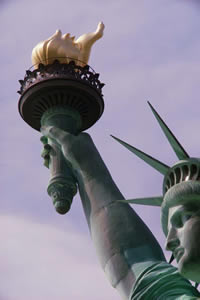 Through one hundred years of biting sea winds, driving rains and beating sun, the copper skin of the Statue of Liberty not only has grown more beautiful but also has remained virtually intact.
Through one hundred years of biting sea winds, driving rains and beating sun, the copper skin of the Statue of Liberty not only has grown more beautiful but also has remained virtually intact.
While a glance at the Statue's rich, green patina provides proof of copper's enduring good looks, closer analysis shows that weathering and oxidation of the copper skin has amounted to just .005 of an inch in a century.
For this reason, the copper skin was one of the few major elements of the Statue that did not need to be significantly rebuilt or completely replaced when the Statue was renovated for its centennial.
The only copper part of the Statue that required renovation was the torch section, which was rebuilt with new copper and patinated before installation to match the rich, green color of the existing copper - testimony to copper's unique ability to grow more attractive over the years.
Copper played a key role in the restoration of the Statue inside, as well as outside. High-alloy copper saddles and rivets now secure the copper skin to the skeleton underneath. The copper fastenings ensure structural integrity and, as part of the total materials system, guard against any galvanic reaction problems.
The copper and brass industry provided technical advice on restoration of the copper components of the Statue, and it performed a similar service for these components at the adjacent Ellis Island restoration project. New copper replaced the missing copper domes and roofing, plus other features like globes, flashing, cornices, gutters, downspouts and the louvers of the long-abandoned Great Hall.
The most dramatic part of the restoration was the recladding of the Beaux-Arts domes of the Great Hall. That project alone called for 8,000 square feet of copper sheet. More up-to-date techniques made the copper installation easier and more enduring.
Copper clearly was a good idea a hundred years ago. With technological advances, copper is still a great idea today.
